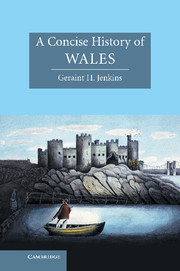Book contents
- Frontmatter
- Contents
- List of illustrations
- Preface
- 1 The earliest inhabitants
- 2 The Heroic Age, 383–1063
- 3 The Anglo-Norman conquerors, c. 1063–1282
- 4 Pestilence, rebellion and renewal, c. 1283–1536
- 5 Early modern Wales, 1536–1776
- 6 A crucible of the modern world, 1776–1900
- 7 Wales awakening? 1901–2006
- 8 Whither Wales?
- Sources of quotations
- Guide to further reading
- Index
- CAMBRIDGE CONCISE HISTORIES
6 - A crucible of the modern world, 1776–1900
Published online by Cambridge University Press: 05 June 2014
- Frontmatter
- Contents
- List of illustrations
- Preface
- 1 The earliest inhabitants
- 2 The Heroic Age, 383–1063
- 3 The Anglo-Norman conquerors, c. 1063–1282
- 4 Pestilence, rebellion and renewal, c. 1283–1536
- 5 Early modern Wales, 1536–1776
- 6 A crucible of the modern world, 1776–1900
- 7 Wales awakening? 1901–2006
- 8 Whither Wales?
- Sources of quotations
- Guide to further reading
- Index
- CAMBRIDGE CONCISE HISTORIES
Summary
In late Georgian Wales, Cardiff was a small, modest, down-at-heel market town nestling in the shadow of a ruined castle. Cattle and swine roamed the streets, and the main function of the town was to distribute agricultural goods from surrounding rural areas and manufacturing goods from West Country ports. It was a Tory stronghold and the 1,871 inhabitants enumerated in the 1801 census, most of whom spoke Welsh, bowed to the will of the Bute family. By 1900, however, Cardiff had become, by some distance, the most populous town in Wales and the gateway through which millions of tons of coal travelled in railway wagons to the holds of steam-powered ships in its impressive docks. Prosperous colliery proprietors, shipowners, merchants and bankers basked in Cardiff's reputation as the coal metropolis of the world. It had elected Liberal MPs between 1852 and 1895, and did so again from 1900 to 1910. This dynamic, heavily anglicized and cosmopolitan urban conglomeration had increased its population a hundredfold, and its reward in 1905 was to be granted city status. Fifty more years would pass before it was officially recognized as the capital of Wales, but from 1871 onwards no other town could legitimately challenge its primacy. This astonishing transformation epitomized the changing geography and socio-economic experience of large parts of Wales.
- Type
- Chapter
- Information
- A Concise History of Wales , pp. 173 - 226Publisher: Cambridge University PressPrint publication year: 2007

